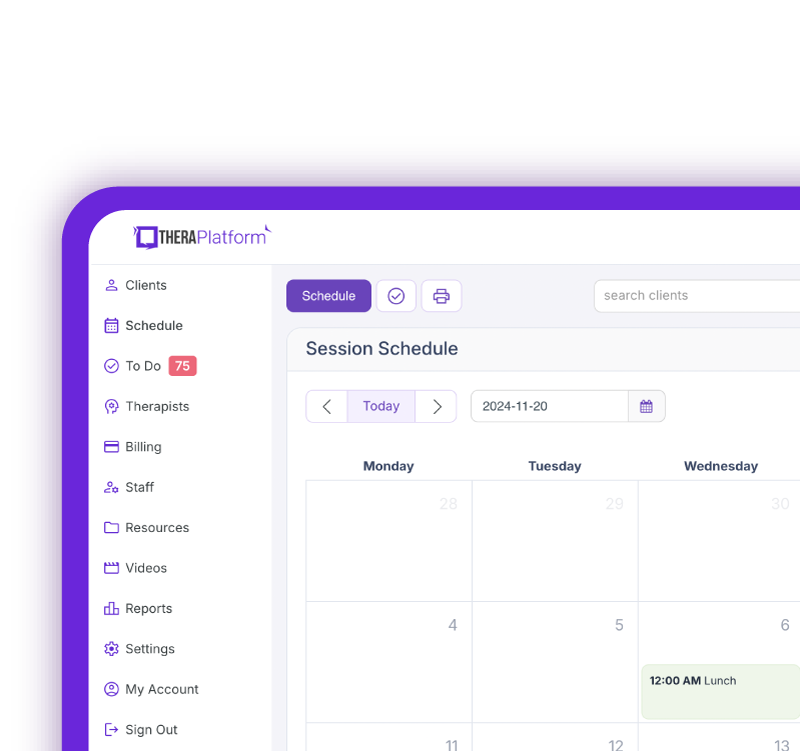Remote therapeutic monitoring

Remote therapeutic monitoring or RTM codes allow physical therapists to bill for remotely managing patients with musculoskeletal and respiratory conditions using software or medical devices that collect non-physiological data.
Approved by CMS in 2022, RTM represents a major expansion in remote care capabilities and reimbursement opportunities.
Summary
- RTM allows therapists to bill for monitoring musculoskeletal and respiratory conditions using FDA-approved devices.
- It creates new revenue streams, improves patient accountability, and supports data-driven care.
- Five RTM CPT codes (98975–98981) define setup, monitoring, and communication billing requirements. Enrolling in an insurance billing course for therapists can help providers enhance their knowledge.
- Successful RTM integration depends on patient education, proper device selection, and EHR integration. By leveraging an EHR like TheraPlatform for efficient documentation and claim submission, therapists can tackle billing with ease.
→ Click here to enroll in our free on-demand Insurance Billing for Therapists video course [Enroll Now]
Since the COVID-19 pandemic, both patients and therapists have increasingly embraced remote care. With RTM, therapists can monitor progress, support accountability, and integrate real-time data into treatment plans while creating new revenue opportunities.
Streamline your insurance billing with One EHR
- Claim batching
- Auto claims
- Automated EOB & ERA
- Real-time claim validation
- Real-time claim tracking
- Aging and other reports

What is remote therapeutic monitoring?
In the 2022 Medicare Fee Schedule, CMS introduced five new RTM CPT codes. Unlike remote physiologic monitoring (RPM), which tracks data such as heart rate, oxygen levels, and glucose, RTM focuses on non-physiologic data related to therapeutic treatment and the musculoskeletal or respiratory systems.
Examples include:
- Adherence to a home exercise program
- Symptom response
- Device-based monitoring in outpatient or home health settings
These RTM CPT codes are not applicable in inpatient rehab or SNFs.
Watch this video to see how TheraPlatform’s EHR saves time on insurance billing
Benefits of RTM
For patients
Regular monitoring helps patients stay accountable and motivated to follow their care plans, while frequent therapist check-ins improve communication and make it easier to track goals. At the same time, patients develop greater self-awareness, gaining valuable insight into their own progress and outcomes.
For therapists and practices
Remote therapeutic monitoring (RTM) enhances practice efficiency by enabling real-time data collection that supports quicker clinical decisions and individualized care. It also creates new revenue opportunities through billable services, strengthens outcomes documentation to justify medical necessity and continued treatment, and reduces cancellations by keeping patients engaged throughout their care.
Who can bill using RTM CPT codes?
Eligible providers who can bill using RTM CPT codes include?
- Physical, occupational, and speech therapists
- PTAs and COTAs
- Physicians, nurse practitioners, and physician assistants
- Psychologists and clinical social workers (in many cases)
Practice Management + EHR + Telehealth
Manage more in less time in your practice with TheraPlatform

RTM CPT codes and billing guidance
RTM CPT code | Description | Time requirement |
|---|---|---|
98975 | Device set-up and patient education | N/A |
98976 | Monitoring respiratory system | 16+ days/30 days |
98977 | Monitoring musculoskeletal system | 16+ days/30 days |
98980 | Patient-provider communication | First 20 minutes |
98981 | Additional patient-provider communication | Each additional 20 minutes |
Key notes
- RTM CPT codes 98976 and 98977 are device-specific (respiratory and musculoskeletal).
- RTM CPT codes 98975, 98980, and 98981 apply more broadly.
- The RTM CPT code 98975 is subject to PTA payment adjustments while 98976 and 98977 are not.
- Documentation must detail device use, education provided, data reviewed, and patient understanding.
RTM CPT code billing considerations
- Services must be medically reasonable and necessary.
- RTM and RPM cannot be billed together for the same patient.
- RTM may be billed concurrently with CCM, TCM, BHI, PCM, or CPM—but time cannot be double counted.
- State Medicaid policies vary and it’s advisable to check local guidelines.
- Private insurers may have specific billing requirements around using RTM CPT codes.
Technology and practice integration
RTM devices must qualify as FDA-defined medical devices, which may include:
- Smart inhalers and spirometers
- Adherence trackers and software as a medical device (SaMD)
- Smartwatches or computer vision technology
Best practices for using RTM devices
- Ensure patients are comfortable with the device.
- Provide education and troubleshooting support.
- Combine RTM with telehealth or hybrid care models.
- Use RTM data to determine when in-person care is needed.
RTM with EHRs
Integrating RTM with your EHR and billing software streamlines documentation and reimbursement.
- RTM CPT code billing and documentation tools
- HIPAA-compliant telehealth
- Automated reminders and note templates
- Streamlined scheduling and reporting
Practice Management + EHR + Telehealth
Manage more in less time in your practice with TheraPlatform

How EHR and practice management software can save you time with insurance billing for therapists
EHRs with integrated billing software and clearing houses, such as TheraPlatform, offer therapists significant advantages in creating an efficient insurance billing process. The key is minimizing the amount of time dedicated to developing, sending, and tracking medical claims through features such as automation and batching.
What are automation and batching?
- Automation refers to setting up software to perform tasks with limited human interaction.
- Batching or performing administrative tasks in blocks of time at once allows you to perform a task from a single entry point with less clicking.
Which billing and medical claim tasks can be automated and batched through billing software?
- Invoices: Create multiple invoices for multiple clients with a click or two of a button or set up auto-invoice creation, and the software will automatically create invoices for you at the preferred time. You can even have the system automatically send invoices to your clients.
- Credit card processing: Charge multiple clients with a click of a button or set up auto credit card billing, and the billing software will automatically charge the card (easier than swiping!)
- Email payment reminders: Never manually send another reminder email for payment again, or skip this altogether by enabling auto credit card charges.
- Automated claim creation and submission: Batch multiple claims with one button click or turn auto claim creation and submission on.
- Live claim validation: The system reviews each claim to catch any human errors before submission, saving you time and reducing rejected claims.
- Automated payment posting: Streamline posting procedures for paid medical claims with ERA. When insurance offers ERA, all their payments will post automatically on TheraPlatform's EHR.
- Tracking: Track payment and profits, including aging invoices, overdue invoices, transactions, billed services, service providers.
Utilizing billing software integrated with an EHR and practice management software can make storing and sharing billing and insurance easy and save providers time when it comes to insurance billing for therapists.
Streamline your practice with One EHR
- Scheduling
- Flexible notes
- Template library
- Billing & payments
- Insurance claims
- Client portal
- Telehealth
- E-fax

Resources
TheraPlatform is an all-in-one EHR, practice management, and teletherapy software with AI-powered notes built for therapists to help them save time on admin tasks. It offers a 30-day risk-free trial with no credit card required and supports different industries and sizes of practices, including physical therapists in group and solo practices.
More resources
- Therapy resources and worksheets
- Therapy private practice courses
- Ultimate teletherapy ebook
- The Ultimate Insurance Billing Guide for Therapists
- The Ultimate Guide to Starting a Private Therapy Practice
- Mental health credentialing
- Insurance billing 101
- Practice management tools
- Behavioral Health tools
Free video classes
- Free on-demand insurance billing for therapist course
- Free mini video lessons to enhance your private practice
- 9 Admin tasks to automate in your private practice
References
FAQs about remote therapeutic monitoring
What is the difference between RTM and RPM?
RTM tracks non-physiological data like exercise adherence and symptom response, while RPM tracks physiological measures such as heart rate or blood glucose.
Can PTAs and COTAs bill for RTM?
Yes, but some codes (like 98975) are subject to PTA/COTA payment adjustments. Device monitoring codes (98976, 98977) are not.
Which devices qualify for RTM billing?
Any device that meets the FDA definition of a medical device, such as spirometers, smart inhalers, adherence trackers, or SaMD.



